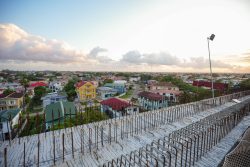Almost 174 years ago eighty-three men and women who had been freed from slavery paid the price of 30,000 guilders for what was then known as plantation Northbrook, a cotton plantation of about 500 acres, and today that plantation is known as the village of Victoria, fondly referred to as the ‘first village.’
November 7, 1839 will mark 174 years since the men and women who came from five plantations ‒ Ann’s Grove, Dochfour, Enmore, Hope ‒ came together to buy the plantation, and it is recorded that two-thirds of the money was paid right away in coins, delivered in wheelbarrows, some of them still black with mud from the fields. The remainder was covered by a promissory note which was redeemed three weeks later.
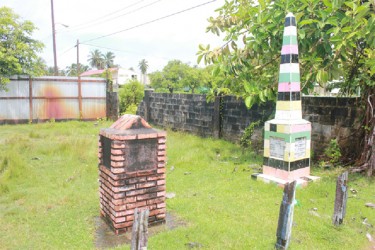
And so it was a proud people who became residents of the village, which for many years was self-sufficient because of the large-scale farming that took place. Once upon time too, there were also many coconut factories located in the village.
In addition, the inhabitants took advantage of the schooling which over time became available for their children, and down the decades Victoria nurtured many doctors, lawyers, educators and professionals of all kinds who helped to make their village famous along the length of the coastland.
Today many would say that the village is a far cry from what it once was in years gone by, and depending on whom you speak to different reasons are put forward for its decline. This is despite the fact that the houses have been transformed in to modern-day ‘fancy’ homes and the school buildings are on par with others around the country.
Today many villagers are the owners of vehicles, but even those who are not, no longer have to make the long trek up the Victoria Middle Walk (the main road in the village) to the public road to access transportation, as there are now endless taxis available to them.
There is a gas station at the beginning of the village and the front is lined with many taxis waiting for passengers. There are also some shops which provide a liming spot for the young.
But you know something is wrong when you look at what is called the Emancipation Hut, said to have been the pay office during apprenticeship, and see that it is in dire need of rehabilitation. Residents did band themselves together to protest against the authorities demolishing the building recently, but for many that sort of cooperation on which the village was founded, is what is lacking nowadays, and it is this, they say, which has caused the decline of the village.
Just next door to the hut there is a Christian Brethren church, but during slavery times the building was known as the cotton bond. Today it is rickety and could pose a risk to life and limb for those who use it. What they call the Victoria Cultural Centre has lost all its culture and the roofless building is a vivid demonstration of the neglect of the village’s heritage.
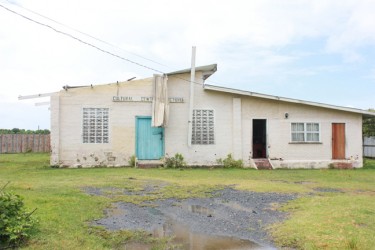
For some it is a case of the “first become the last,” because of the state of the village and what they described as neglect by the authorities, but for others it is the neglect of the villagers themselves. One man pointed out that if the residents are proud of what their ancestors did then they would want to keep their rich historical heritage alive.
“We were very proud of that [the first village to be bought by former slaves] but that is going down the drain now,” one young man commented to this newspaper during a recent visit, while another standing next to him pointed out that young people now have to concentrate on making money and making a life for themselves.
“The pride is melting,” another said reflectively, all of them refusing to go on record with their comments.
One recalled that in the past there were self-help groups which saw residents coming together to clean the drains and beautify the village, but that does not happen any more even as his friends chime in that this is the responsibility of the relevant authorities.
“Sound like if you are begging but there is a lot of work that needs to be done,” and for some it does not make sense speaking as it is “like throwing water on duck back.”
But there are many who see Victoria as more than just their home but as a village with a history, and according to Nicole Wood Victorians are hard-working people and while there are ups and downs these are more like “crime of passion, because you and dem can just done row, and something happen and you call on them, they would come and help.”
“I born and grow here and I wouldn’t left here for nothing; they could give me a free house in Georgetown all and I wouldn’t lef, I like Victoria man, and in here you could mine livestock and so on,” Wood said proudly.
‘Breadbasket’
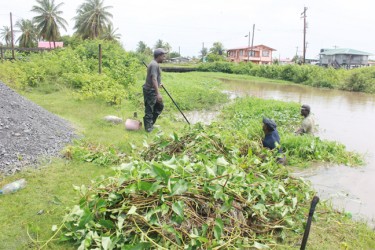
Maybe one of the authorities the young men referred to is the Grove/Haslington Neighbourhood Democratic Council but acting Chairman of the council, 72-year-old William Frank, said that the council can so much and no more, and where he is concerned residents cannot just want more but must do more.
Frank was born and grew up in Victoria and even though he has been “in and out,” the village has always been his home as his foreparents belonged there and just as it does for many of its occupants, he said, the village of Victoria “means a lot to me.”
Describing the village as once being the “breadbasket” of the East Coast the ardent cricket fan said that he grew up and found his elders farming, and even though he branched off to other areas of work, farming is still something he does.
“You find now the young people nowadays, dem ain’t going into farming, they are more interested in doing work outside like construction and mining and things like that. But the older people them, let’s say like my age group and so go in the backdam and farm,” he said.
He pointed out that many of the young are only utilised to help with the foundations of buildings but are not needed after this is completed because they do not have the skills.
The backdam of the village is now almost abandoned, even though there are still a few people who make the long, sometimes muddy trek to farm, but apart from the many coconut trees there is little else to show that this village was once almost self-sufficient and considered to be the breadbasket of the East Coast.
“We are not cooperating as we should; if you go down the back is sheer bush,” the NDC chairman commented.
The village was also deeply religious at one time, but Frank said the young are no longer interested and he feels that “we were better people in those days… the young would not be performing on the road and so on, we were more respectful.”
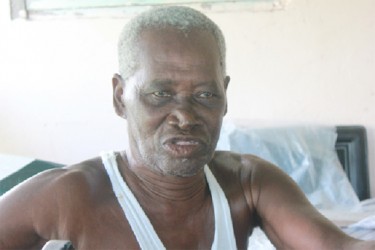
“Victoria really was a nice place in the past…” he continued, with a serious expression as if wishing that the village could once again be transformed into its ‘glory days’ where villagers were proud of the sacrifices their ancestors made and the present generation worked to keep it as the prized inheritance it once was.
“The village is having a rich history but we the residents are not following it up… I don’t know where we are going…” he said.
Most of the lands people live on have been passed down from one generation to the next and one of the good traditions that has been maintained is that persons are not parting with the land by way of sale; the transports are passed down from one relative to another, keeping the land in the family.
Frank does not see any development in Victoria, and when probed as to whose fault this might be he said candidly that it is the residents of the village who are responsible for this, even if the authorities might not completely fulfil their obligations.
“Even if the authorities are lacking, you have to move away from that; if you want to develop yourself you have to try,” he said, adding that the former slaves pooled their resources to acquire the village and the onus is on their descendants to do just that to ensure the village remains a proud aspect of African history.
He made mention of the Emancipation Hut, which serves as a shop, and the dilapidated building that was once the cotton bond, and said the state of both buildings is a classic example of the fact that the residents place little value on preserving Victoria’s history. He pointed out that the village has no less than 60 carpenters and he has been “begging” for some time for them together to work on making the buildings better and not wait on the authorities to get it done. But his appeals have so far fallen on deaf ears.
He said that the poor state of the culture centre was compounded by the fact that a recent storm blew off its roof, and since then the NDC has written the regional office for assistance in replacing the roof since the council does not have the money to do so. Part of the building also serves as the village office where rates and taxes are collected. In that compound also there is a monument that has the names of the 83 purchasers of the village, but it stands in a compound which is unkempt.
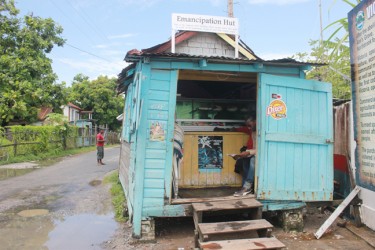
The NDC chairman lamented the state of the Victoria ground disclosing that they have been trying to work with the Victoria football club to return the ground to its glory days, but sadly again, many do not feel inclined to assist. There is the Victoria Reconstruction Trust that aims to restore the landmarks in the village, but as with many things cash is a problem.
“If the 83 ex-slaves that buy the village should come back to see what going on now, they would go back and don’t want come back at all,” he said sadly.
“I cannot say from the time I growing up to now I see any real significant development in the village, and that is so sad, how it look on our behalf?” he asked, adding that everyone born in the village had the heritage but was “not taking care of it.”
He pointed out that the council is cash strapped as it depends on the rates and taxes most of which go back into covering administrative costs, and they still have to repair streets and bridges as best as they can. Central government gives the council $3M a year, and before the money is disbursed the council has to identify the projects on which the money would be utilized. And this money has to spread across the various villages which come under the council.
Coconut factories
Sixty-two-year-old Mabel Kingston bemoans the demise of the many coconut factories that provided ready employment for villagers.
Married to one of the well-known villagers, Herbert Kingston ‒ better known as ‘Bag Rice’ because of the amount of rice he ate as a child and who even has a street named after his moniker ‒ Kingston said she was born in Cove & John but has been living in Victoria since she was a child.
“Growing up most of the people I know use to farm, who didn’t plant farm they use to do coconut oil work because they had many coconut factories in the village,” she said. Today there is just one remaining.
Surrounded by heaps of sewing in her Victoria home ‒ she took only a few minutes off of her work on the machine to speak to this newspaper ‒ she said that back then it was not just the oil from the coconut that kept the factories going but also fibre which was used to make mattresses, and the shell of the coconut which was used to boil the oil.
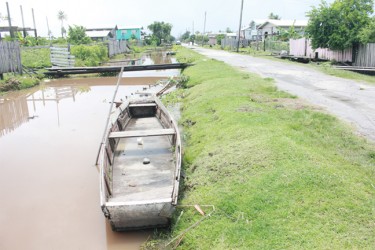
“It is a bad thing that we don’t have the factories any more because I could remember growing up a lot of young people use to work at the factories and even older people, a lot of house wives use to work and was nearby to their children and not like now, they have to go out the village to look for work,” she said.
The industry not only employed many persons directly but also other residents supplied the factories with coconuts, thus providing income to families.
“We use to do coconut old work and as a matter of fact we build this house with coconut oil,” she said.
Many persons were also involved in making cassava bread but she said only one family in the village does this today.
For her the village has not progressed because in her young days it had much more to offer. She is of the opinion that most persons do not farm because of the constant flooding and many of the men are now travelling into the interior resulting in a large number of them returning stricken with malaria.
“In those days you would not find young men just out of school going into the interior but now it happening… because the village does not have anything to offer,” she said, adding that those who further their education have to leave the village to seek employment in the city and other places.
Another villager, Samuel Blackett, 60, said both of his parents were born in the village, his father from the back of the village and his mother at the front.
“From the line [railway embankment] going over the road you used to call road people and from the line coming back you used to call backdam people, so there was a kind of segregation. But where my mother and father is concerned they use to say, well, my father was the first man from down at the back go and get a lady from the road,” Blackett explained with a laugh.
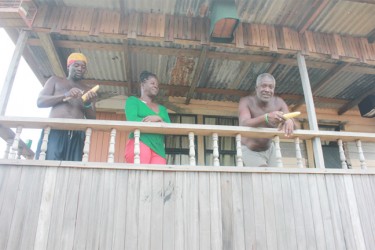
He also recalled that many persons used to farm and while he worked at the then Guyana Electricity Corporation (GEC) he still farmed and when he retired in 1995 he continued this and reared animals.
“I still plant my lil kitchen garden,” he said proudly.
He said much more should be done in the village and pointed out that the main access road is in a deplorable condition in some sections.
One of the good things for him is the fact that most of the persons are born and bred Victorian and known to each other, unlike some other areas which have persons from different parts of the country.
“Other than that the village is very peaceful, and I am proud of it,” he said.

